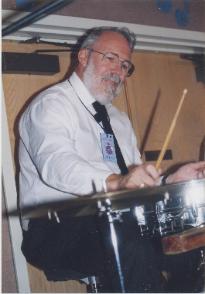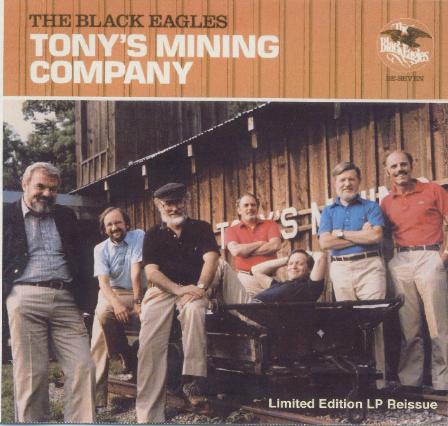CD REVIEW
by Bert Thompson
NEW BLACK EAGLE JAZZ BAND—A MIDSUMMER NIGHT’S DREAM (OWN
LABEL: BE[LECD]4004). Playing time: 63m. 32s.
NEW BLACK EAGLE JAZZ BAND—TONY’S MINING COMPANY (OWN LABEL: BE
[LECD]4005). Playing time: 72m. 54s.
You Always Hurt the One You Love*; Big House Blues; When I Leave the World
Behind#; Georgia Cabin; El Albanico; Sing On; Panama; I Remember When; Lily of the
Valley; Swipesey Cakewalk; That’s My Home*; Stevedore Stomp.
Recorded at Mount Gretna, Pennsylvania, on June 21 & 22, 1985.
Personnel: Tony Pringle, cornet, leader, vocal*; Hugh Blackwell, clarinet, soprano sax;
Stan Vincent, trombone; Bob Pilsbury, piano, vocal#; Peter Bullis, banjo, manager; C. H.
“Pam” Pameijer, drums; Eli Newberger, tuba.
This is the fifth in a series of fourteen limited edition CD’s, reissuing material by the
band that previously appeared on LP’s—mainly on their own label but also on a few
other small labels, such as Philo, Philips, and Dirty Shame—and on cassette tapes.
Some of these cassettes were issued simultaneously with the LP’s but also contained
additional tracks. Other cassettes with different material were issued in that format
only. When the company that produced the cassettes went out of business, the digital
masters were returned to the band. These form the basis of most of the material on this
CD set.
This recording emanates from one of the many visits the band has made over the years
to Mount Gretna. The title, “Tony’s Mining Company,” is something of a pun, referring
at one and the same time to a small restaurant in Mount Gretna by that name and, of
course, the band itself—leader Tony [Pringle]’s group which mines so successfully the
tunes it digs into.
If this is the first experience the reader has of the New Black Eagles music, it is a good
introduction because this recording exhibits everything that makes them arguably the
finest traditional jazz band extant - period.
Their musicianship is impeccable. Although almost any track could suffice to illustrate
this, Big House Blues is a good example. As befits an Ellington tune, the front line
harmonies in the opening and closing choruses are exquisite. The toms Pameijer uses in
the “jungle sound” strain, which is led by the wah wah muted cornet of leader Pringle,
are most appropriate. Vincent’s spare trombone solo rightly deserves the vocal plaudits
offered by Pringle at its conclusion, and Blackwell’s plaintive clarinet solo fits exactly
the mood of the piece. Newberger shows the depths—and the heights—to which his
tuba can go, while Pilsbury displays a multiplicity of rhythms, both on his solo and in
his backing of other soloists, on piano. And as he does everywhere, Bullis lays down
that solid four/four chording on banjo. Each tune on this recording could thus
exemplify the group’s virtuosity. And the applause from the audience at the end of
each number is indicative of how much this musicianship is appreciated.
The selection of tunes and tempos contributes much to the interest this CD elicits. There
is contrast in ordering of the tunes, resulting in tempos almost alternating between fast
and slow. This contrast is shown even in the pair of Ellington tunes, the somber mood
of Ellington’s Big House Blues in opposition to the joyful one of his Stevedore Stomp,
the latter enhanced by the fast four-four coupled with the amazing tuba work which
never fails to astonish me.
The tune list includes El Albanico, a Spanish march much embraced by several British
army regiments and an unlikely candidate for a traditional jazz interpretation, which it
gets here in no small measure. (The only other instance I know of a jazz band’s making
a jazz vehicle of this tune is one by the Acker Bilk aggregation.) There is also the fine
full-band interpretation of the disc’s only rag, Swipesey Cakewalk, taken at a jaunty
tempo. Of four tracks not on original LP, two are spirituals, Sing On and Lily of the
Valley, which are given outstanding renditions.
Another kind of variety is that afforded by the several rhythms, from two-four to four-
four to shuffle, sometimes switching among them even within the same tune.
Mention must also be made of the sheer exuberance, both in the playing and in the
attitude one senses. Quite audible is the encouragement and approbation the band
members offer each other, especially on solos. When one member is soloing, there is no
talking among the others, no showing little respect for their colleague or interest in what
he is doing, but rather the reverse—close attention is paid to the soloist, punctuated
with the approving comments and then a verbal pat on the back at the end. Such spur
the musicians on to even greater efforts. These traits, I would add, are exhibited in all of
the band’s recordings and concerts, not just this one.
Lastly, there are not many vocals on this recording, but I would cavil a little with the one
on That’s My Home, where Pringle attempts an Armstrong imitation. Armstrong is
really, like Dickens, inimitable. However, I did appreciate the nice little allusion to his
original home when he changes the river from “Swanee” of the song’s lyrics to “Mersey”
of England!
This is an album that all lovers of traditional jazz should not be without. According to
the band, ordering information is as follows:
The 14 CD’s are a set only in that they represent 14 reissues of LPs and Cassettes from
the earlier days of the Black Eagles. We have not priced them as a set and have typically
sold them as individual items. You can find them by going to -
http://www.blackeagles.com/x.fullsite/cgi-bin/online-orderform.asp
To the right of the window you will see four lists - aisle 1, 2, 3 and 4. Click on aisle 2 and
you will have an order form listing all 14 of the CDs.
|
|



